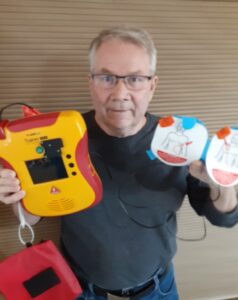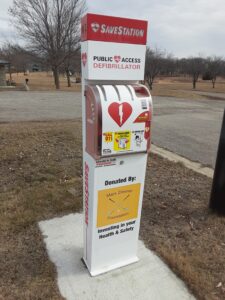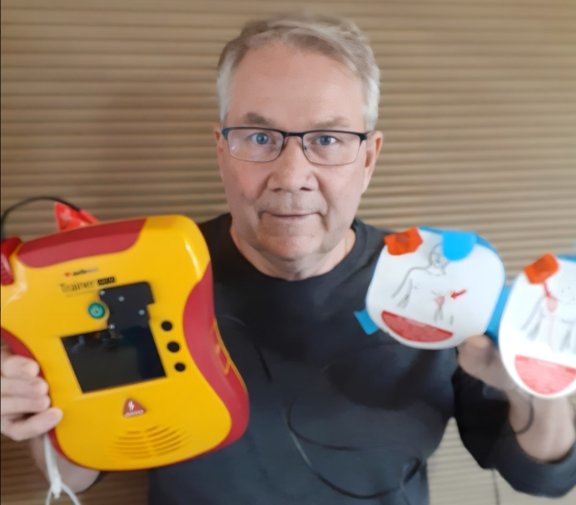by MaryAnne Block
Imagine a family member suddenly collapses, loses consciousness and stops breathing. What would you do? The first thing to remember is to call 911, then start cardio-pulmonary resuscitation. It is even better if someone can quickly locate and bring an AED (automated external defibrillator) to the scene.
There are currently 18 outdoor AED “Save Stations” in St. Joseph, nine located in Sartell and one in St. Stephen thanks to a pilot program started by St. Joseph resident Joel Vogel and friend Rich Feneis of Sartell along with the non-profit they created, Advocates for Health, Lifesaving Solutions.
Now, by going to the website “Pulse Point” (or downloading its app on your phone), one can see where nearly 160,000 outdoor AEDs are located in the United States.
The inspiration and passion behind Advocates for Health dates back to May 2004 when Vogel suffered a heart attack at home while doing yardwork. After a ride in the ambulance to St. Cloud Hospital he was rushed into the emergency room. His “widow-maker” artery was clogged 100 percent. The other four were 90, 80, 80 and 70. Six stents later, Vogel’s view of life was changed forever. This is when he began volunteering with a local organization to advocate for increased public education and the importance of CPR/AED training.
Years ago it was thought whenever someone lost consciousness and collapsed, it was due to a “heart attack.” Now, medical personnel know it might not be due to a heart attack (which is caused by a blocked artery that prevents blood from circulating to the arteries on the outside of the heart). Instead, the cause might be a “cardiac arrest.”
Unlike a heart attack, a cardiac arrest is due to an “electrical” problem. That malfunction, also called an arrhythmia, can result in preventing the heart from pumping a life-giving blood supply to the brain, lungs and other organs. Either situation might result in a person losing consciousness.
According to the American Heart Association, most heart attacks do not lead to cardiac arrests, although they can be linked. It is estimated 350,000 people die each year from sudden cardiac arrest, the leading cause of death in the United States.
In either case, calling 911 and starting CPR are essential. But what about the AED? That device can be a vital key to saving lives. That fact prompted the Advocates for Health organization to place AEDs in easily accessible outdoor locations throughout the state, plus inside businesses. AEDs are for public use in emergencies, and it is wise to learn where they are located.
Stearns County and especially St. Joseph were key areas when the Advocates for Health started its campaign to place AEDS at certain locations. When St. Joseph resident Vogel, started to volunteer in the Mended Hearts program, he learned there were 482 life-saving AEDs in Stearns County. But all AEDs were locked inside facilities and were not readily available to the public. Over time, each and every AED was located, mapped out and then given to the 911 dispatchers to inform deputies responding to emergency calls. But Advocates for Health was just getting started.
At first, there were concerns about outdoor placement, including units being stolen, someone trying to shock a drunk buddy or outdoor temperature extremes of heat or cold that diminished battery effectiveness.
“We had a vision,” Vogel said. “Our vision was placing AEDs in outdoor ‘smart-monitored cabinets’ while training community members on how to perform CPR and how to use an AED.”
That is when a friend of Vogel’s, Rich Feneis of Sartell, decided to get involved. They began to problem-solve, then got grant funding for the entirely new concept of having AEDs readily available to the public.
The cabinets now have fans and heaters to control the temperature inside the outdoor cabinet. That extends the life of the AED batteries. The AED sites also provide other emergency information and training.
People should also learn more than the locations of the nearest AEDs in their areas. The cabinet box is easy to open by pulling down both sides of the clear housing. This will start a loud alarm, letting others know in the area that there is an emergency and to respond. As the door opens, a photo is taken of the person opening the housing, plus 911 is immediately notified. The AED, which is less than eight pounds, has two chest pads in the back of the unit, and a tracking device so the AED location is followed wherever it is used. It also sends texts to the 911 dispatchers so they know what is being done.
The AED screen shows where to place the sensing pads on the victim’s chest. CPR is stopped during the assessment, and no one is to touch the patient. The AED senses the patient’s pulse. If a shock is required, it will provide the electrical stimulus to stabilize the heart rhythm. CPR is resumed if necessary. The simple step-by-step directions are on the AED screen and also available on the phone app RescueMeCPR. A second shock can be delivered after two minutes, if indicated.
By doing hands-on-only CPR and using an AED in a timely manner, lives can be saved. The odds of surviving a sudden cardiac arrest increase from 5 percent to 75 percent when CPR and AED are promptly started and continued until emergency medical responders arrive.
The Advocates for Health started in Stearns County and has grown to all of Minnesota. It also has AED units in South Dakota, Iowa, Florida, Connecticut and Virginia and the demand continues to grow.
It is good to learn CPR, to locate the AED units in one’s immediate area and to download the Pulse Point and Rescue MeCPR apps on your phone. Instead of being numbed by endless cell phone scrolling, learn more about AEDs no matter where you live or travel. (The more populated areas tend to have more units available).
Remember the life you save might be a stranger, a neighbor or a family member.


This is a free-standing AED “Save Station” at Klinefelter Park in St. Joseph.




